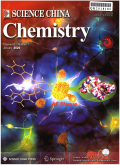- 钛学术文献服务平台 \
- 学术期刊 \
- 基础科学期刊 \
- 自然科学总论期刊 \
- 中国科学:化学(英文版)期刊 \
null
Ultra-sensitive detection of uranyl ions with a specially designed high-efficiency SERS-based microfluidic device
基本信息来源于合作网站,原文需代理用户跳转至来源网站获取
摘要:
The uranyl ion (UO22+) poses high risks to human health and the environment,hence its detection and monitoring is of utmost significance.However,the development of an ultra-sensitive,high-efficiency and convenient approach for on-site detection of UO22+ remains a challenge.Herein,a reliable and reusable surface-enhanced Raman spectroscopy (SERS)-based microfluidic biosensor was developed for rapid detection of UO22+ in real samples.The detection protocol involved the reaction of 5'-Rhodamine B (RhB)-labeled double-stranded DNA for UO22+-specific DNAzyme-cleavage reaction in a U-shaped microchannel.Then,the reaction products were delivered into three parallel samples for high-throughput tests by SERS biochips,where 3D ZnO-Ag mesoporous nanosheet arrays (MNSs) were modified with a single-stranded DNA (ssDNA).The ssDNA was sequence-complementary with the 5'-RhB-labeled cleaved-stranded DNA (csDNA) from the reaction products.By the hybridization of ssDNA and csDNA,the signal probe RhB was fixed close to the surface of the ZnO-Ag MNSs to enhance the Raman signal.The limit of detection for UO22+ with the microfluidic-SERS biosensor was 3.71 × 10-15 M.An over 20,000-fold selectivity towards UO22+ response was also achieved in the presence of 15 other metal ions.The high-throughput microfluidicSERS biosensor operated well for practical UO22-detection,with excellent recoveries in contaminated river and tap water from 95.2% to 106.3% (relative standard deviation (RSD) <6.0%,n=6).Although the SERS-based microfluidic biosensor developed in this study was deployed for the detection of UO22+,the reusable and high-efficiency system may be expanded to the detection of other analytes on-site.

推荐文章
期刊_丙丁烷TDLAS测量系统的吸收峰自动检测
带间级联激光器
调谐半导体激光吸收光谱
雾剂检漏 中红外吸收峰 洛伦兹光谱线型
不同盐度、温度及光照对漂浮浒苔生理生态的影响
浒苔
盐度
温度
光照
生理生态
期刊_联合空间信息的改进低秩稀疏矩阵分解的高光谱异常目标检测
高光谱图像
异常目标检测 低秩稀疏矩阵分解 稀疏矩阵 残差矩阵
内容分析
关键词云
关键词热度
相关文献总数
(/次)
(/年)
文献信息
| 篇名 | Ultra-sensitive detection of uranyl ions with a specially designed high-efficiency SERS-based microfluidic device | ||
| 来源期刊 | 中国科学:化学(英文版) | 学科 | |
| 关键词 | |||
| 年,卷(期) | 2019,(8) | 所属期刊栏目 | |
| 研究方向 | 页码范围 | 1064-1071 | |
| 页数 | 8页 | 分类号 | |
| 字数 | 语种 | 英文 | |
| DOI | |||
五维指标
引文网络
引文网络
二级参考文献 (0)
共引文献 (0)
参考文献 (10)
节点文献
引证文献 (0)
同被引文献 (0)
二级引证文献 (0)
1999(1)
- 参考文献(1)
- 二级参考文献(0)
2007(1)
- 参考文献(1)
- 二级参考文献(0)
2011(1)
- 参考文献(1)
- 二级参考文献(0)
2012(1)
- 参考文献(1)
- 二级参考文献(0)
2014(1)
- 参考文献(1)
- 二级参考文献(0)
2015(2)
- 参考文献(2)
- 二级参考文献(0)
2016(2)
- 参考文献(2)
- 二级参考文献(0)
2017(1)
- 参考文献(1)
- 二级参考文献(0)
2019(0)
- 参考文献(0)
- 二级参考文献(0)
- 引证文献(0)
- 二级引证文献(0)
引文网络交叉学科
相关学者/机构
期刊影响力
中国科学:化学(英文版)
主办单位:
中国科学院
出版周期:
月刊
ISSN:
1674-7291
CN:
11-5839/O6
开本:
16开
出版地:
北京东黄城根北街16号
邮发代号:
创刊时间:
1950
语种:
eng
出版文献量(篇)
4060
总下载数(次)
0
总被引数(次)
11421
期刊文献
相关文献
推荐文献
- 期刊分类
- 期刊(年)
- 期刊(期)
- 期刊推荐
力学
化学
地球物理学
地质学
基础科学综合
大学学报
天文学
天文学、地球科学
数学
气象学
海洋学
物理学
生物学
生物科学
自然地理学和测绘学
自然科学总论
自然科学理论与方法
资源科学
非线性科学与系统科学
中国科学:化学(英文版)2022
中国科学:化学(英文版)2021
中国科学:化学(英文版)2020
中国科学:化学(英文版)2019
中国科学:化学(英文版)2018
中国科学:化学(英文版)2017
中国科学:化学(英文版)2016
中国科学:化学(英文版)2015
中国科学:化学(英文版)2014
中国科学:化学(英文版)2013
中国科学:化学(英文版)2012
中国科学:化学(英文版)2011
中国科学:化学(英文版)2010
中国科学:化学(英文版)2009
中国科学:化学(英文版)2008
中国科学:化学(英文版)2007
中国科学:化学(英文版)2006
中国科学:化学(英文版)2005
中国科学:化学(英文版)2004
中国科学:化学(英文版)2003
中国科学:化学(英文版)2002
中国科学:化学(英文版)2001
中国科学:化学(英文版)2000
中国科学:化学(英文版)2019年第9期
中国科学:化学(英文版)2019年第8期
中国科学:化学(英文版)2019年第7期
中国科学:化学(英文版)2019年第6期
中国科学:化学(英文版)2019年第5期
中国科学:化学(英文版)2019年第4期
中国科学:化学(英文版)2019年第3期
中国科学:化学(英文版)2019年第2期
中国科学:化学(英文版)2019年第12期
中国科学:化学(英文版)2019年第11期
中国科学:化学(英文版)2019年第10期
中国科学:化学(英文版)2019年第1期

 免费查重
免费查重










